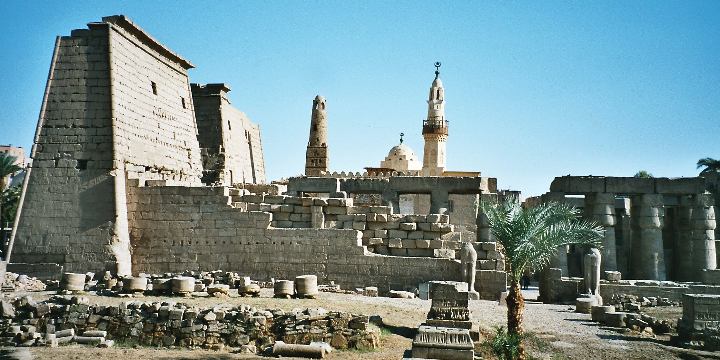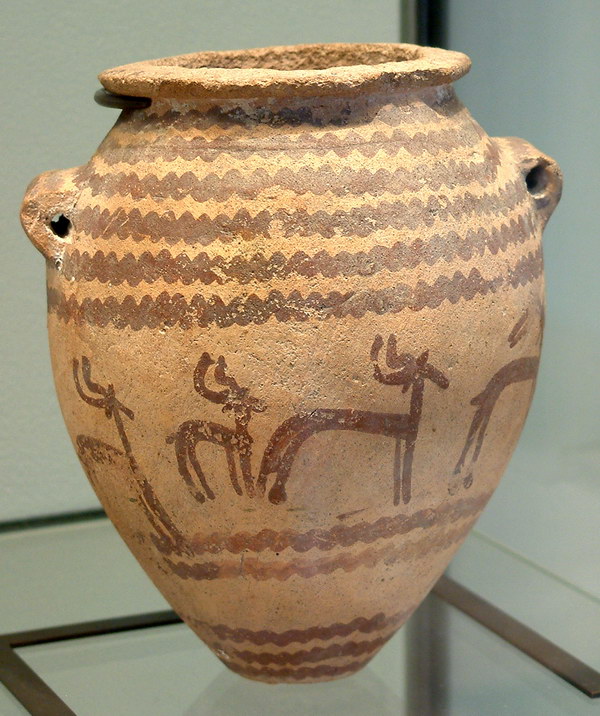|
New Kingdom Of Egypt
The New Kingdom, also referred to as the Egyptian Empire, is the period in ancient Egyptian history between the sixteenth century BC and the eleventh century BC, covering the Eighteenth, Nineteenth, and Twentieth dynasties of Egypt. Radiocarbon dating places the beginning of the New Kingdom between 1570 BC and 1544 BC. The New Kingdom followed the Second Intermediate Period and was succeeded by the Third Intermediate Period. It was Egypt's most prosperous time and marked the peak of its power. The concept of a "New Kingdom" as one of three "golden ages" was coined in 1845 by German Egyptologist Baron von Bunsen, and its definition would evolve significantly throughout the nineteenth and twentieth centuries. The later part of this period, under the Nineteenth and Twentieth dynasties (1292–1069 BC), is also known as the ''Ramesside period''. It is named after the eleven pharaohs who took the name Ramesses, after Ramesses I, the founder of the Nineteenth Dynasty. Possibly ... [...More Info...] [...Related Items...] OR: [Wikipedia] [Google] [Baidu] |
Twentieth Dynasty Of Egypt
The Twentieth Dynasty of Egypt (notated Dynasty XX, alternatively 20th Dynasty or Dynasty 20) is the third and last dynasty of the Ancient Egyptian New Kingdom period, lasting from 1189 BC to 1077 BC. The 19th and 20th Dynasties furthermore together constitute an era known as the ''Ramesside period''. This dynasty is generally considered to be the start of the decline of Ancient Egypt. History Background Upon the death of the last pharaoh of the 19th Dynasty, Queen Twosret, Egypt descended into a period of civil war, as attested by the Elephantine stela built by Setnakhte. The circumstances of Twosret's demise are uncertain, as she may have died peacefully during her reign or been overthrown by Setnakhte, who was likely already middle aged at the time. 20th Dynasty A consistent theme of this dynasty was the loss of pharaonic power to the High Priests of Amun. Horemheb, a pharaoh of the 18th Dynasty, had restored the traditional Ancient Egyptian religion and the priesthood ... [...More Info...] [...Related Items...] OR: [Wikipedia] [Google] [Baidu] |
Imperial Cult
An imperial cult is a form of state religion in which an emperor or a dynasty of emperors (or rulers of another title) are worshipped as demigods or deities. "Cult" here is used to mean "worship", not in the modern pejorative sense. The cult may be one of personality in the case of a newly arisen Euhemerus figure, or one of national identity (e.g., Ancient Egyptian Pharaoh or Empire of Japan) or supranational identity in the case of a multi-ethnic state (e.g., Imperial China, Roman Empire). A ''divine king'' is a monarch who is held in a special religious significance by his subjects, and serves as both head of state and a deity or head religious figure. This system of government combines theocracy with an absolute monarchy. Historical imperial cults Ancient Egypt The Ancient Egyptian pharaohs were, throughout ancient Egyptian history, believed to be incarnations of the deity Horus; thereby derived by being the son of Osiris, the afterlife deity, and Isis, goddess of marriage ... [...More Info...] [...Related Items...] OR: [Wikipedia] [Google] [Baidu] |
Ramesses XI
Menmaatre Ramesses XI (also written Ramses and Rameses) reigned from 1107 BC to 1078 BC or 1077 BC and was the tenth and final pharaoh of the Twentieth Dynasty of Egypt and as such, was the last king of the New Kingdom period. He ruled Egypt for at least 29 years although some Egyptologists think he could have ruled for as long as 30. The latter figure would be up to 2 years beyond this king's highest known date of Year 10 of the ''Whm Mswt'' era or Year 28 of his reign. One scholar, Ad Thijs, has suggested that Ramesses XI could even have reigned as long as 33 years. It is believed that Ramesses ruled into his Year 29 since a graffito records that the general and High Priest of Amun Piankh returned to Thebes from Nubia on III Shemu day 23—or just 3 days into what would have been the start of Ramesses XI's 29th regnal year. Piankh is known to have campaigned in Nubia during Year 28 of Ramesses XI's reign (or Year 10 of the Whm Mswt) and would have returned home to Egypt in the ... [...More Info...] [...Related Items...] OR: [Wikipedia] [Google] [Baidu] |
Christian Charles Josias Von Bunsen
Christian Charles or Karl Josias von Bunsen (25 August 1791 – 28 November 1860), also known as , was a German diplomat and scholar. Life Early life Bunsen was born at Korbach, an old town in the German principality of Waldeck. His father was a farmer who was driven by poverty to become a soldier. Having studied at the Korbach gymnasium (a type of superior state grammar school) and Marburg University, Bunsen went in his nineteenth year to Göttingen, where he studied philosophy under Christian Gottlob Heyne, and supported himself by teaching and later by acting as tutor to William Backhouse Astor, John Jacob's son. Bunsen had been recommended to Astor by Heyne. He won the university prize essay of the year 1812 with his treatise ''De Iure Atheniensium Hœreditario'' (“Athenian Law of Inheritance”), and a few months later the University of Jena granted him the honorary degree of doctor of philosophy. During 1813 he traveled extensively with Astor in Germany and Ital ... [...More Info...] [...Related Items...] OR: [Wikipedia] [Google] [Baidu] |
Egypt
Egypt ( ar, مصر , ), officially the Arab Republic of Egypt, is a transcontinental country spanning the northeast corner of Africa and southwest corner of Asia via a land bridge formed by the Sinai Peninsula. It is bordered by the Mediterranean Sea to the north, the Gaza Strip of Palestine and Israel to the northeast, the Red Sea to the east, Sudan to the south, and Libya to the west. The Gulf of Aqaba in the northeast separates Egypt from Jordan and Saudi Arabia. Cairo is the capital and largest city of Egypt, while Alexandria, the second-largest city, is an important industrial and tourist hub at the Mediterranean coast. At approximately 100 million inhabitants, Egypt is the 14th-most populated country in the world. Egypt has one of the longest histories of any country, tracing its heritage along the Nile Delta back to the 6th–4th millennia BCE. Considered a cradle of civilisation, Ancient Egypt saw some of the earliest developments of writing, agriculture, ur ... [...More Info...] [...Related Items...] OR: [Wikipedia] [Google] [Baidu] |
Third Intermediate Period Of Egypt
The Third Intermediate Period of ancient Egypt began with the death of Pharaoh Ramesses XI in 1077 BC, which ended the New Kingdom, and was eventually followed by the Late Period. Various points are offered as the beginning for the latter era, though it is most often regarded as dating from the foundation of the Twenty-Sixth Dynasty by Psamtik I in 664 BC, following the departure of the Nubian Kushite rulers of the Twenty-fifth Dynasty after they were driven out by the Assyrians under King Ashurbanipal. The concept of a "Third Intermediate Period" was coined in 1978 by British Egyptologist Kenneth Kitchen. The period was one of decline and political instability, coinciding with the Late Bronze Age collapse of civilizations in the ancient Near East and Eastern Mediterranean (including the Greek Dark Ages). It was marked by division of the state for much of the period and conquest and rule by non-native Egyptians. History Twenty-first Dynasty The period of the Twe ... [...More Info...] [...Related Items...] OR: [Wikipedia] [Google] [Baidu] |
Second Intermediate Period Of Egypt
The Second Intermediate Period marks a period when ancient Egypt fell into disarray for a second time, between the end of the Middle Kingdom and the start of the New Kingdom. The concept of a "Second Intermediate Period" was coined in 1942 by German Egyptologist Hanns Stock. It is best known as the period when the Hyksos people of West Asia made their appearance in Egypt and whose reign comprised the 15th Dynasty, which, according to Manetho's ''Aegyptiaca'', was founded by a king by the name of Salitis. End of the Middle Kingdom The 12th Dynasty of Egypt came to an end at the end of the 19th century BC with the death of Queen Sobekneferu (1806–1802 BC).Kim S. B. Ryholt, ''The Political Situation in Egypt during the Second Intermediate Period, c. 1800–1550 B.C.'', Museum Tusculanum Press, Carsten Niebuhr Institute Publications 20. 1997, p.185 Apparently she had no heirs, causing the 12th Dynasty to come to a sudden end, and, with it, the Golden Age of the Middle Ki ... [...More Info...] [...Related Items...] OR: [Wikipedia] [Google] [Baidu] |
Radiocarbon Dating
Radiocarbon dating (also referred to as carbon dating or carbon-14 dating) is a method for determining the age of an object containing organic material by using the properties of radiocarbon, a radioactive isotope of carbon. The method was developed in the late 1940s at the University of Chicago by Willard Libby. It is based on the fact that radiocarbon () is constantly being created in the Earth's atmosphere by the interaction of cosmic rays with atmospheric nitrogen. The resulting combines with atmospheric oxygen to form radioactive carbon dioxide, which is incorporated into plants by photosynthesis; animals then acquire by eating the plants. When the animal or plant dies, it stops exchanging carbon with its environment, and thereafter the amount of it contains begins to decrease as the undergoes radioactive decay. Measuring the amount of in a sample from a dead plant or animal, such as a piece of wood or a fragment of bone, provides information that can be used to calc ... [...More Info...] [...Related Items...] OR: [Wikipedia] [Google] [Baidu] |
Nineteenth Dynasty Of Egypt
The Nineteenth Dynasty of Egypt (notated Dynasty XIX), also known as the Ramessid dynasty, is classified as the second Dynasty of the Ancient Egyptian New Kingdom period, lasting from 1292 BC to 1189 BC. The 19th Dynasty and the 20th Dynasty furthermore together constitute an era known as the ''Ramesside period''. This Dynasty was founded by Vizier Ramesses I, whom Pharaoh Horemheb chose as his successor to the throne. History Background The warrior kings of the early 18th Dynasty had encountered only little resistance from neighbouring kingdoms, allowing them to expand their realm of influence easily, but the international situation had changed radically towards the end of the dynasty. The Hittites had gradually extended their influence into Syria and Canaan to become a major power in international politics, a power that both Seti I and his son Ramesses II would confront in the future. 19th Dynasty Seti and Ramesses II The New Kingdom of Egypt reached the zenith of ... [...More Info...] [...Related Items...] OR: [Wikipedia] [Google] [Baidu] |
History Of Ancient Egypt
The history of ancient Egypt spans the period from the early prehistoric settlements of the northern Nile valley to the Roman conquest of Egypt in 30 BC. The pharaonic period, the period in which Egypt was ruled by a pharaoh, is dated from the 32nd century BC, when Upper and Lower Egypt were unified, until the country fell under Macedonian rule in 332 BC. Chronology ;Note: For alternative 'revisions' to the chronology of Egypt, see Egyptian chronology. Egypt's history is split into several different periods according to the ruling dynasty of each pharaoh. The dating of events is still a subject of research. The conservative dates are not supported by any reliable absolute date for a span of about three millennia. The following is the list according to conventional Egyptian chronology. * Prehistoric Egypt (prior to 3100 BC) * Naqada III ("the protodynastic period", approximately 3100–3000 BC; sometimes referred to as "Dynasty 0") * Early Dynastic Period (First– Second D ... [...More Info...] [...Related Items...] OR: [Wikipedia] [Google] [Baidu] |




